

Untitled. The city of Hiroshima stands on a flat river delta on the Japanese island of Honshu.
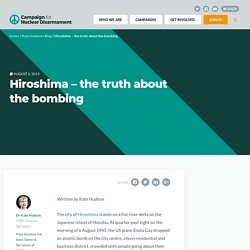
At quarter past eight on the morning of 6 August 1945, the US plane Enola Gay dropped an atomic bomb on the city centre, a busy residential and business district, crowded with people going about their daily business. The bomb, called ‘Little Boy’ because of its long, thin shape, was made from uranium 235. The Doomsday Doctrine. This week we’re thinking about Nuclear Doomsday.
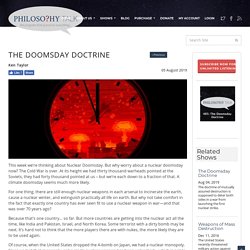
Energy Department Plan to Reclassify Nuclear Waste Worries Environmentalists. The U.S.
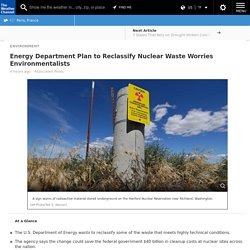
Department of Energy wants to reclassify some of the waste that meets highly technical conditions.The agency says the change could save the federal government $40 billion in cleanup costs at nuclear sites across the nation. About 56 million gallons of radioactive and hazardous chemical wastes are stored in tanks in Washington state. Environmentalists fear a U.S. Joachim Ronneberg, Leader of Raid That Thwarted a Nazi Atomic Bomb, Dies at 99. A 35-man British commando team had been lost on a 1942 mission to sabotage the plant. Britain then enlisted the Norwegian volunteers under Mr. Ronneberg for Operation Gunnerside, endorsed by Prime Minister Winston Churchill.
Air attacks were not ordered for fear of heavy casualties to Norwegian workers and a low probability of success because the heavy water had been distilled in a basement fortified against bombs. After training in Britain, the group parachuted into Norway. A four-member advance team with a radio and supplies went first, in October 1942. A world without nuclear weapons. How Many Nuclear Weapons Exist? U.N. Calls for Total Elimination of Nukes. Breaking News Emails Get breaking news alerts and special reports.
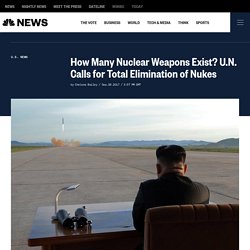
The news and stories that matter, delivered weekday mornings. As a hot war between the U.S. and North Korea over Pyongyang's nuclear weapons aspirations appeared to inch closer to reality, the United Nations' fourth annual International Day for the Total Elimination of Nuclear Weapon comes at a historic moment of brinkmanship. North Korea’s foreign minister, Ri Yong Ho, said Monday that President Donald Trump had "declared war" on his country and that it had the right to shoot down U.S. bombers.
Where are the world's nuclear weapons? That is, of course, a rapidly developing situation.
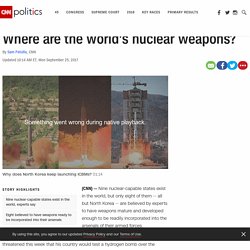
A North Korean official threatened this week that his country would test a hydrogen bomb over the Pacific Ocean after President Donald Trump called North Korean leader Kim Jong Un "rocket man" and the North Korean shot back that Trump was a "dotard. " The road to North Korea's weapons capability follows decades of ups and downs as nuclear states such as the United States and Russia have built up and dismantled their programs. Nuclear arsenals. Nine countries together possess around 15,000 nuclear weapons.
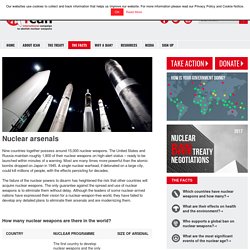
The United States and Russia maintain roughly 1,800 of their nuclear weapons on high-alert status – ready to be launched within minutes of a warning. How Artificial Intelligence Could Increase the Risk of Nuclear War. All you wanted to know about nuclear war but were too afraid to ask. Which countries have nuclear weapons?

There are nine countries that possess nuclear weapons. Hiroshima - the truth about the bombing. The city of Hiroshima stands on a flat river delta on the Japanese island of Honshu.
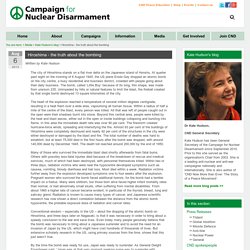
At quarter past eight on the morning of 6 August 1945, the US plane Enola Gay dropped an atomic bomb on the city centre, a busy residential and business district, crowded with people going about their daily business. The bomb, called ‘Little Boy’ because of its long, thin shape, was made from uranium 235. We Didn't Have to Drop the Bomb. Seventy years ago this week, the United States ushered in the age of nuclear terror by dropping atomic bombs on the Japanese cities of Hiroshima and Nagasaki, killing an estimated 200,000 and injuring another 100,000 who would eventually succumb to their wounds or radiation poisoning.
At the time, the American public was led to believe that the bomb helped end the war and “saved lives.” This was never true. Hiroshima, 70 Years Later: Why the United States Bombed the Japanese City. On May 10, 1945, three days after Germany had surrendered to the Allied powers and ended World War II in Europe, a carefully selected group of scientists and military personnel met in an office in Los Alamos, New Mexico.
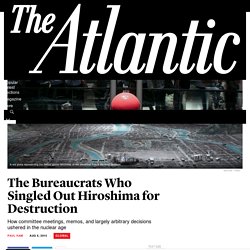
Hiroshima victims' bones reveal how much radiation they experienced after bomb blast - IBTimes India. Hiroshima and Nagasaki stand as a testament to what would happen if a nuclear bomb was ever detonated over a populated area and why it should never be used again in war.
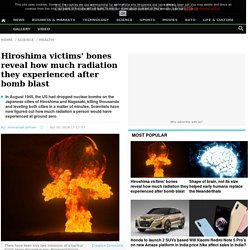
A new research has now found out how much radiation victims of the "cruel bomb" experienced. This study is based on research that started in the 1970s, notes a report by ScienceAlert. Sergio Mascarenhas from the University of Sao Paulo found that X-ray and gamma irradiation led human bones to become "weakly magnetic", this phenomenon was then named paramagnetism. What If the United States Never Dropped the Atomic Bomb? Editor's Note: President Harry S. Truman responded to this article in the weeks after it was published. About a week after V-J Day, I was one of a small group of scientists and engineers interrogating an intelligent, well-informed Japanese Army officer in Yokohama.
We asked him what, in his opinion, would have been the next major move if the war had continued. He replied: "You would probably have tried to invade our homeland with a landing operation on Kyushu about November 1. I think the attack would have been made on such and such beaches. " "Could you have repelled this landing? " The Inevitability of Nuclear War? Nuclear war is coming. Our officials are currently increasing the chances of that. I only write ominous op-ed pieces like this in the spirit of hoping I’m an inaccurate prophet. But I’m unable to avoid the difficult conclusion that nuclear war, absent an immediate, fundamental, worldwide change in attitude, is an inevitable part of our future. It could be weeks, months, or years away.
But it is coming. It could break out at any moment between India and Pakistan, the most likely scenario at present. How I Started Worrying (Again) and Learned to Love an Exhibit About the Bomb. There was a time when I assumed that one day, the sirens would sound, the missiles would rain down, and it would be sayonara, suckers! But as curator John O’Brian stated in his introduction to Bombhead, a new exhibition at the Vancouver Art Gallery, the idea of nuclear annihilation largely disappeared from the public consciousness. “We forgot to be afraid.
Except for artists, who are always paying attention.” The title of the show pertains to the iconic mushroom cloud extruded by an atomic detonation. It is a peculiar shape — part skull, part horrifying chrysanthemum — familiar to anyone whose been around since 1945 or so. If Vladimir Putin’s recent grandstanding is to believed, the nuclear monster is back with a bang. Atomic age 75 years old. Over Christmas vacation in 1938, physicists Lise Meitner and Otto Frisch received puzzling scientific news in a private letter from nuclear chemist Otto Hahn. Nuclear weapons: Who has what? Map: The world has set off at least 2,400 nuclear weapons since 1945. Before the US approves new uranium mining, consider its toxic legacy. 'Charlottesville': A Government Story About Nuclear War. Nuclear deterrence is a myth. And a lethal one at that. Rethinking. In “Why the ’Nuclear Utopians’ Are Wrong” (op-ed, March 16), Keith Payne argues that reductions are unjustified and dangerous.
Nonsense. True realists know that nuclear weapons don’t deter the most likely threats to American security such as political extremism, terrorism, humanitarian disasters, environmental degradation or global financial instability. Realists understand that limited resources must be applied wisely against a full range of threats. Rethinking. "Bombs Away!" Resources. Made from actual mushrooms click 2x.